Analyzing Trial Balance: Finance in the Hospitality Industry
VerifiedAdded on 2024/06/04
|9
|1442
|55
Report
AI Summary
This report provides an analysis of finance in the hospitality industry, focusing on the trial balance, its sources, and structure. It assesses the sources of the trial balance, including journals and ledgers (sales, general, and purchase). The report also evaluates the effects of year-end adjustments such as accruals, prepayments, depreciation, and provisions for doubtful debts on the income statement and balance sheet. The analysis explains how these adjustments impact the overall financial position of a hospitality business. The report concludes by emphasizing the importance of a balanced trial balance and understanding the effects of various financial transactions.
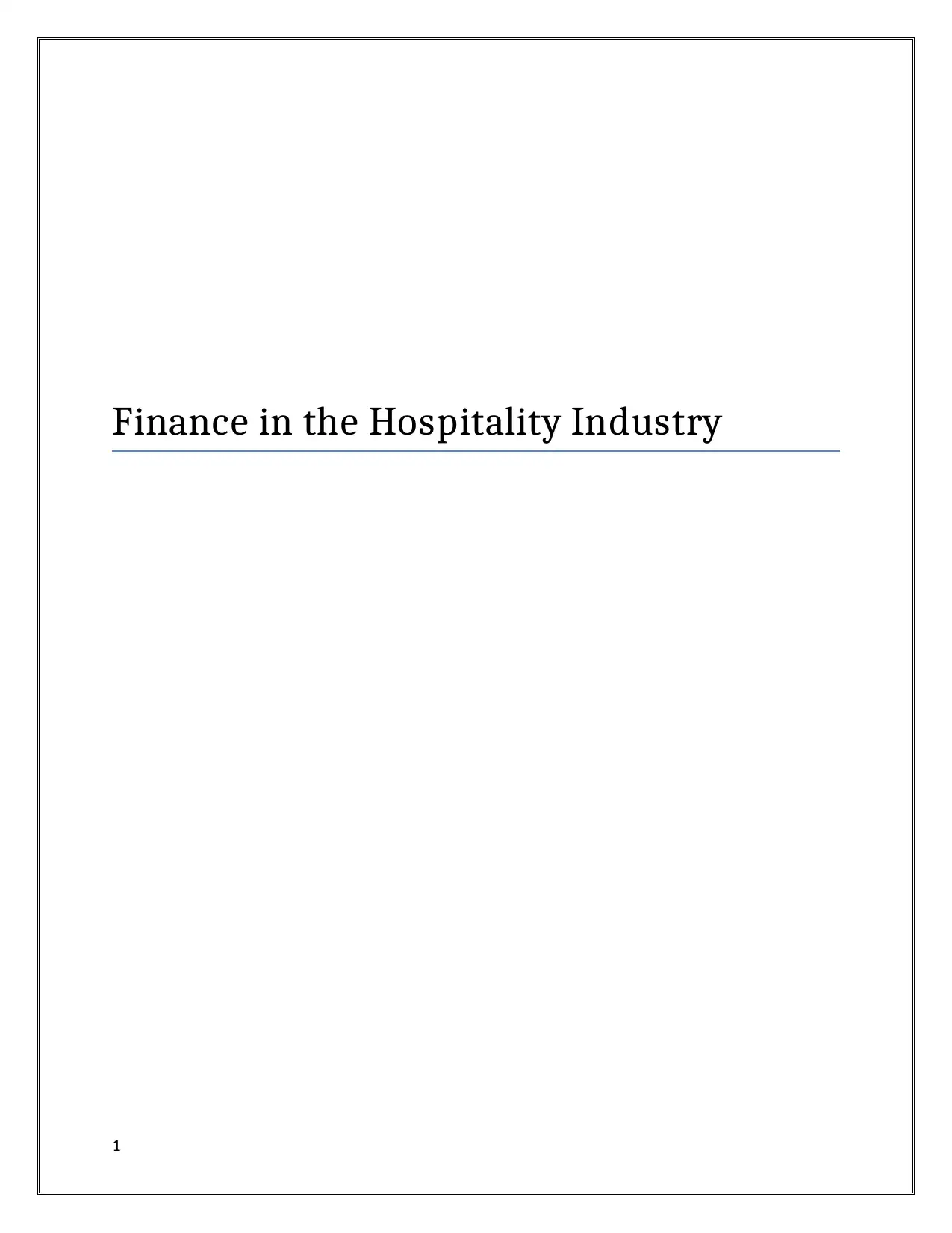
Finance in the Hospitality Industry
1
1
Paraphrase This Document
Need a fresh take? Get an instant paraphrase of this document with our AI Paraphraser
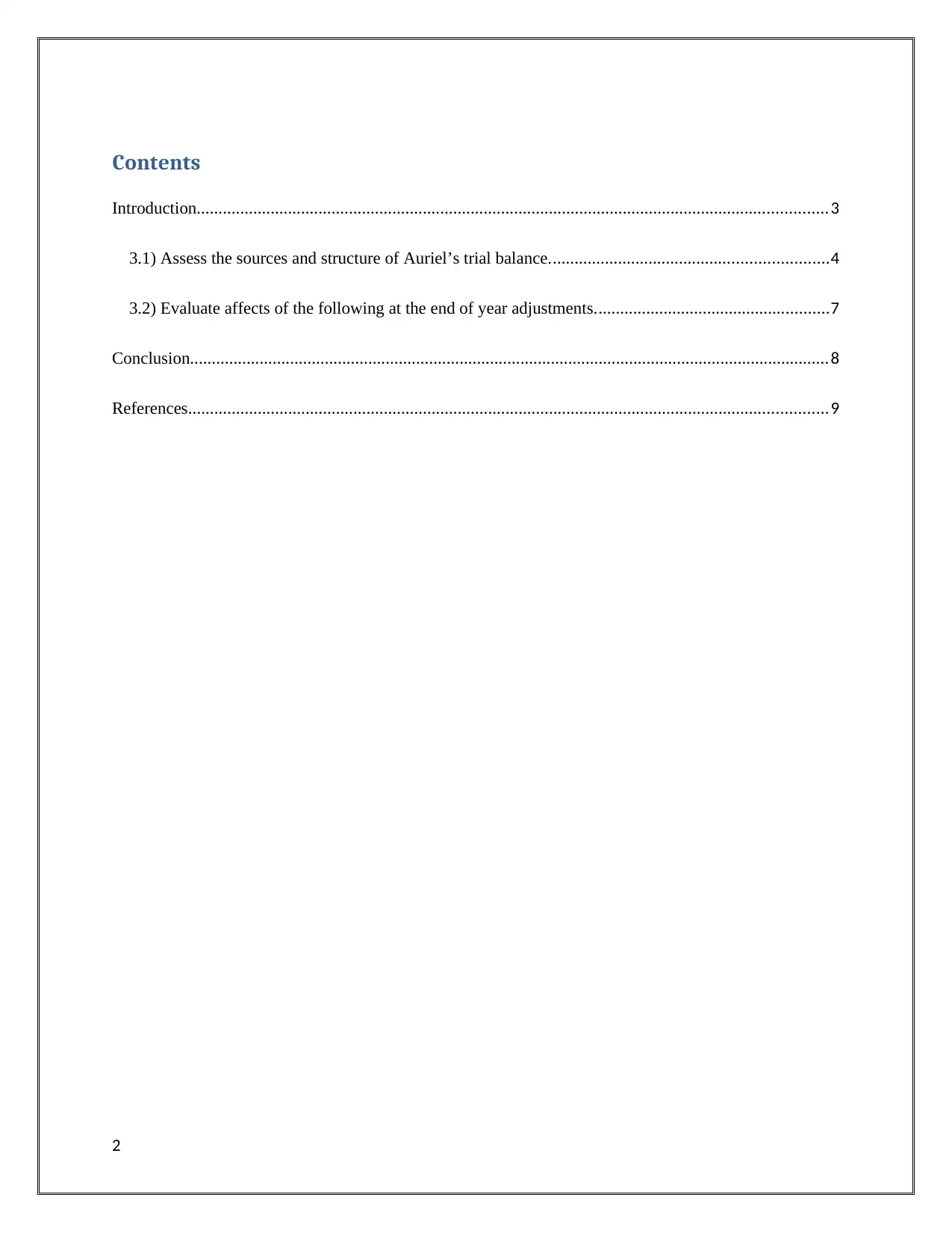
Contents
Introduction.................................................................................................................................................3
3.1) Assess the sources and structure of Auriel’s trial balance................................................................4
3.2) Evaluate affects of the following at the end of year adjustments......................................................7
Conclusion...................................................................................................................................................8
References...................................................................................................................................................9
2
Introduction.................................................................................................................................................3
3.1) Assess the sources and structure of Auriel’s trial balance................................................................4
3.2) Evaluate affects of the following at the end of year adjustments......................................................7
Conclusion...................................................................................................................................................8
References...................................................................................................................................................9
2
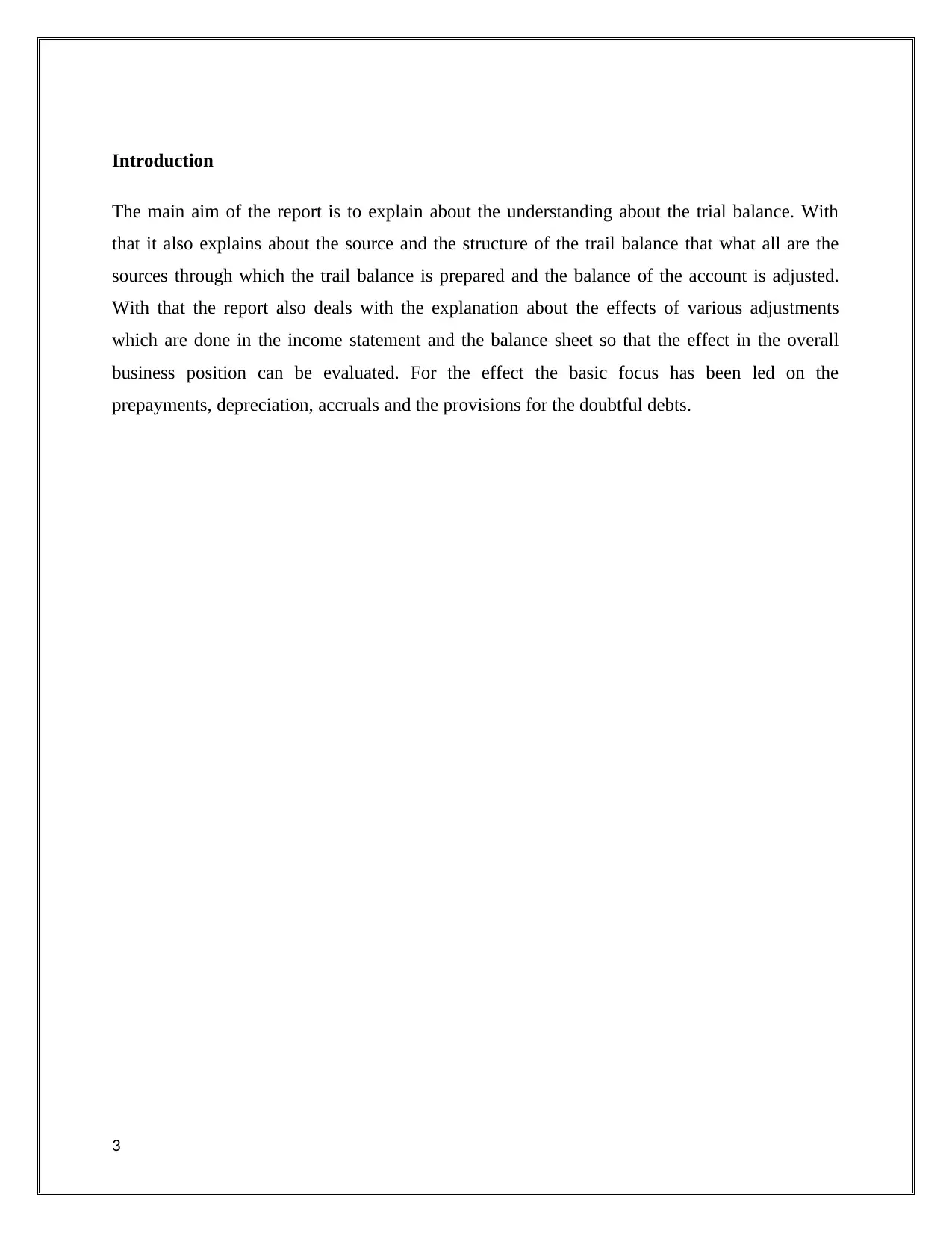
Introduction
The main aim of the report is to explain about the understanding about the trial balance. With
that it also explains about the source and the structure of the trail balance that what all are the
sources through which the trail balance is prepared and the balance of the account is adjusted.
With that the report also deals with the explanation about the effects of various adjustments
which are done in the income statement and the balance sheet so that the effect in the overall
business position can be evaluated. For the effect the basic focus has been led on the
prepayments, depreciation, accruals and the provisions for the doubtful debts.
3
The main aim of the report is to explain about the understanding about the trial balance. With
that it also explains about the source and the structure of the trail balance that what all are the
sources through which the trail balance is prepared and the balance of the account is adjusted.
With that the report also deals with the explanation about the effects of various adjustments
which are done in the income statement and the balance sheet so that the effect in the overall
business position can be evaluated. For the effect the basic focus has been led on the
prepayments, depreciation, accruals and the provisions for the doubtful debts.
3
⊘ This is a preview!⊘
Do you want full access?
Subscribe today to unlock all pages.

Trusted by 1+ million students worldwide
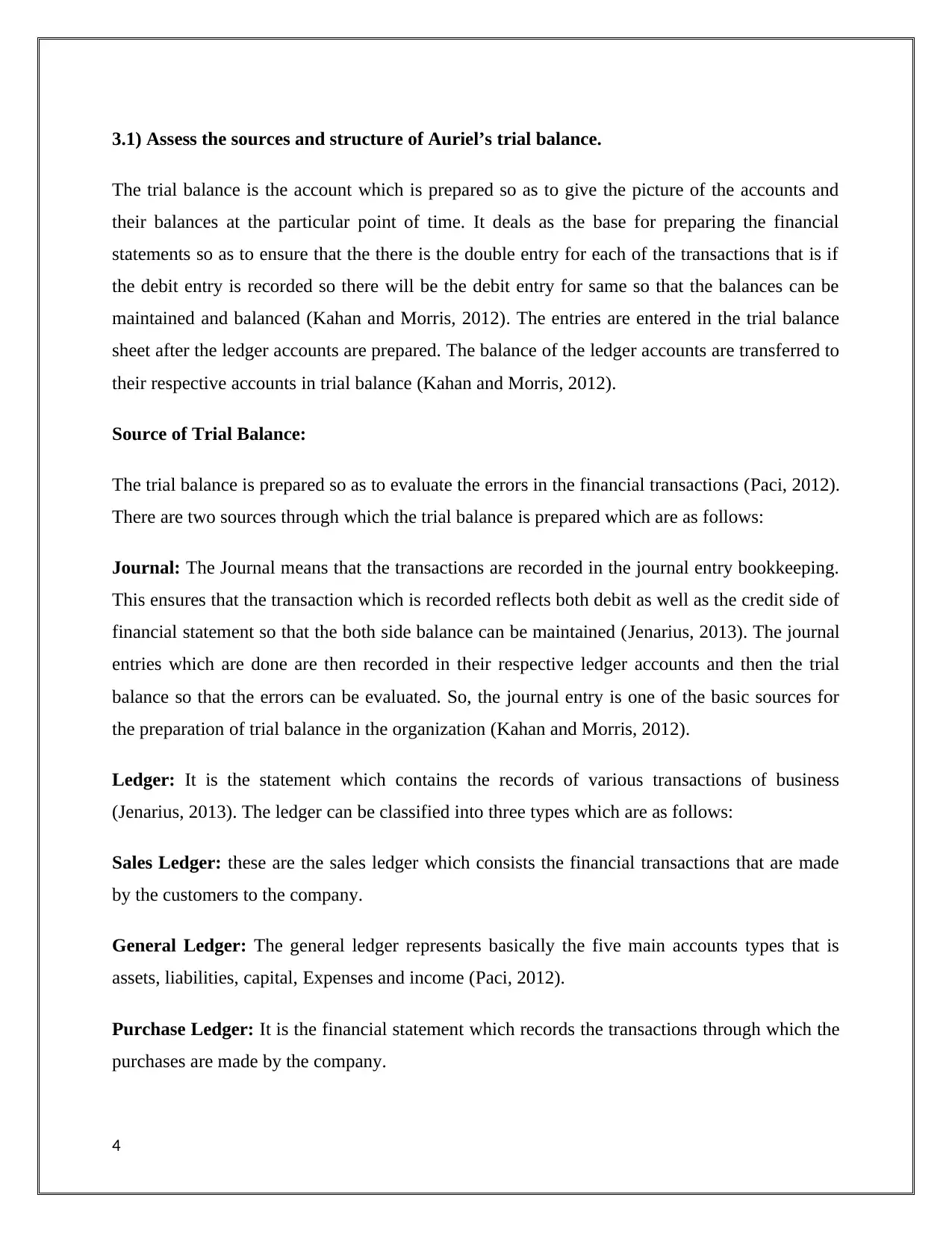
3.1) Assess the sources and structure of Auriel’s trial balance.
The trial balance is the account which is prepared so as to give the picture of the accounts and
their balances at the particular point of time. It deals as the base for preparing the financial
statements so as to ensure that the there is the double entry for each of the transactions that is if
the debit entry is recorded so there will be the debit entry for same so that the balances can be
maintained and balanced (Kahan and Morris, 2012). The entries are entered in the trial balance
sheet after the ledger accounts are prepared. The balance of the ledger accounts are transferred to
their respective accounts in trial balance (Kahan and Morris, 2012).
Source of Trial Balance:
The trial balance is prepared so as to evaluate the errors in the financial transactions (Paci, 2012).
There are two sources through which the trial balance is prepared which are as follows:
Journal: The Journal means that the transactions are recorded in the journal entry bookkeeping.
This ensures that the transaction which is recorded reflects both debit as well as the credit side of
financial statement so that the both side balance can be maintained (Jenarius, 2013). The journal
entries which are done are then recorded in their respective ledger accounts and then the trial
balance so that the errors can be evaluated. So, the journal entry is one of the basic sources for
the preparation of trial balance in the organization (Kahan and Morris, 2012).
Ledger: It is the statement which contains the records of various transactions of business
(Jenarius, 2013). The ledger can be classified into three types which are as follows:
Sales Ledger: these are the sales ledger which consists the financial transactions that are made
by the customers to the company.
General Ledger: The general ledger represents basically the five main accounts types that is
assets, liabilities, capital, Expenses and income (Paci, 2012).
Purchase Ledger: It is the financial statement which records the transactions through which the
purchases are made by the company.
4
The trial balance is the account which is prepared so as to give the picture of the accounts and
their balances at the particular point of time. It deals as the base for preparing the financial
statements so as to ensure that the there is the double entry for each of the transactions that is if
the debit entry is recorded so there will be the debit entry for same so that the balances can be
maintained and balanced (Kahan and Morris, 2012). The entries are entered in the trial balance
sheet after the ledger accounts are prepared. The balance of the ledger accounts are transferred to
their respective accounts in trial balance (Kahan and Morris, 2012).
Source of Trial Balance:
The trial balance is prepared so as to evaluate the errors in the financial transactions (Paci, 2012).
There are two sources through which the trial balance is prepared which are as follows:
Journal: The Journal means that the transactions are recorded in the journal entry bookkeeping.
This ensures that the transaction which is recorded reflects both debit as well as the credit side of
financial statement so that the both side balance can be maintained (Jenarius, 2013). The journal
entries which are done are then recorded in their respective ledger accounts and then the trial
balance so that the errors can be evaluated. So, the journal entry is one of the basic sources for
the preparation of trial balance in the organization (Kahan and Morris, 2012).
Ledger: It is the statement which contains the records of various transactions of business
(Jenarius, 2013). The ledger can be classified into three types which are as follows:
Sales Ledger: these are the sales ledger which consists the financial transactions that are made
by the customers to the company.
General Ledger: The general ledger represents basically the five main accounts types that is
assets, liabilities, capital, Expenses and income (Paci, 2012).
Purchase Ledger: It is the financial statement which records the transactions through which the
purchases are made by the company.
4
Paraphrase This Document
Need a fresh take? Get an instant paraphrase of this document with our AI Paraphraser
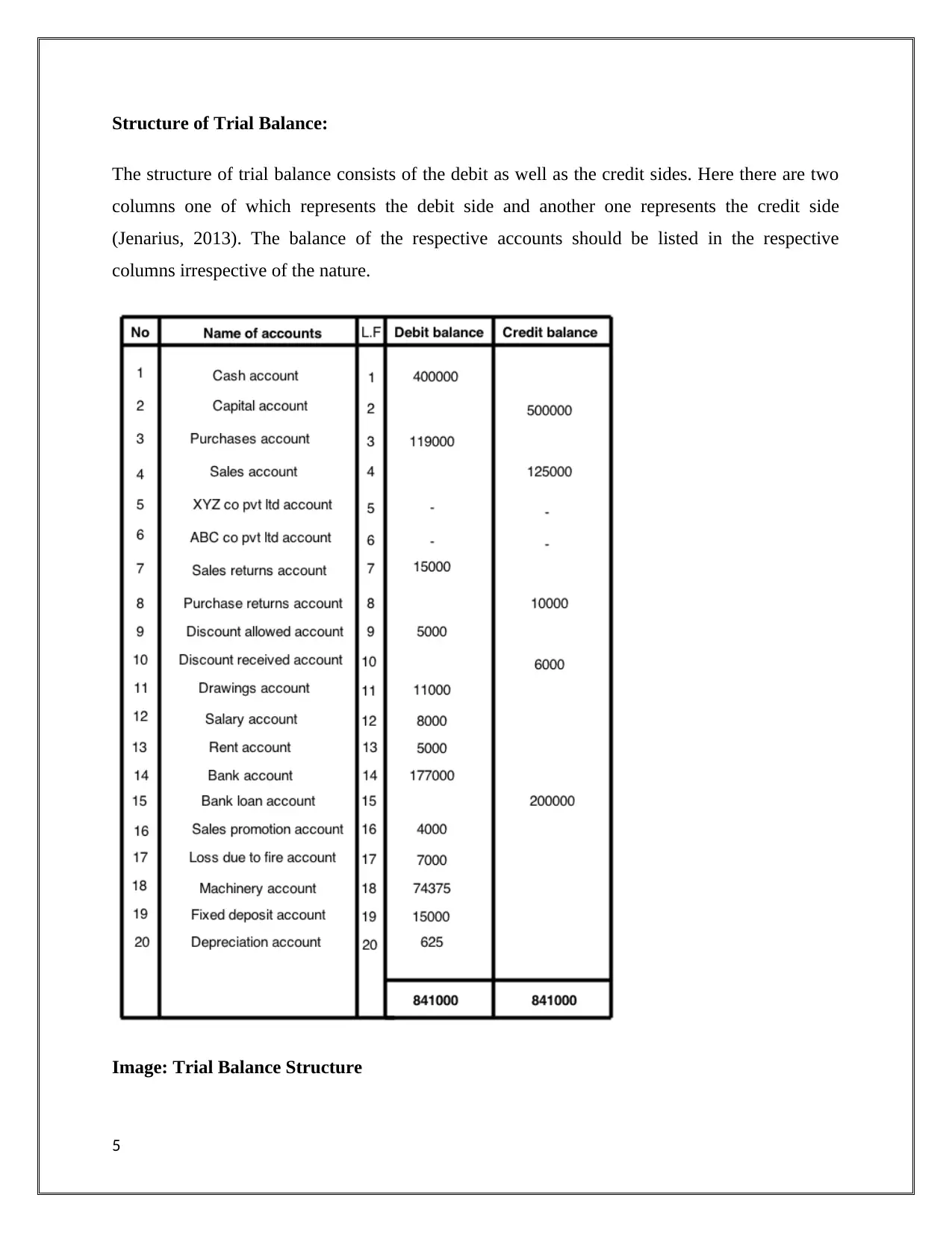
Structure of Trial Balance:
The structure of trial balance consists of the debit as well as the credit sides. Here there are two
columns one of which represents the debit side and another one represents the credit side
(Jenarius, 2013). The balance of the respective accounts should be listed in the respective
columns irrespective of the nature.
Image: Trial Balance Structure
5
The structure of trial balance consists of the debit as well as the credit sides. Here there are two
columns one of which represents the debit side and another one represents the credit side
(Jenarius, 2013). The balance of the respective accounts should be listed in the respective
columns irrespective of the nature.
Image: Trial Balance Structure
5
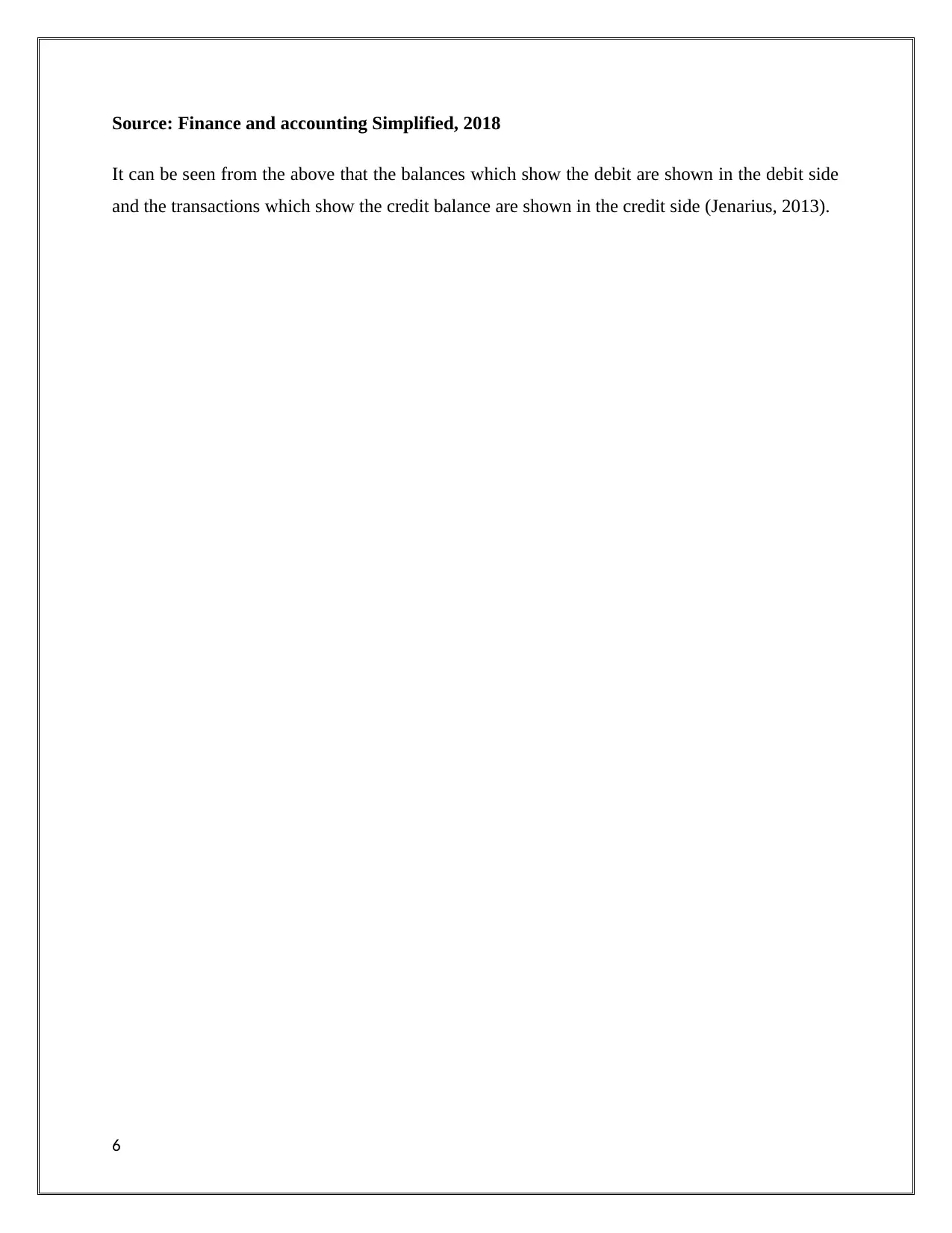
Source: Finance and accounting Simplified, 2018
It can be seen from the above that the balances which show the debit are shown in the debit side
and the transactions which show the credit balance are shown in the credit side (Jenarius, 2013).
6
It can be seen from the above that the balances which show the debit are shown in the debit side
and the transactions which show the credit balance are shown in the credit side (Jenarius, 2013).
6
⊘ This is a preview!⊘
Do you want full access?
Subscribe today to unlock all pages.

Trusted by 1+ million students worldwide
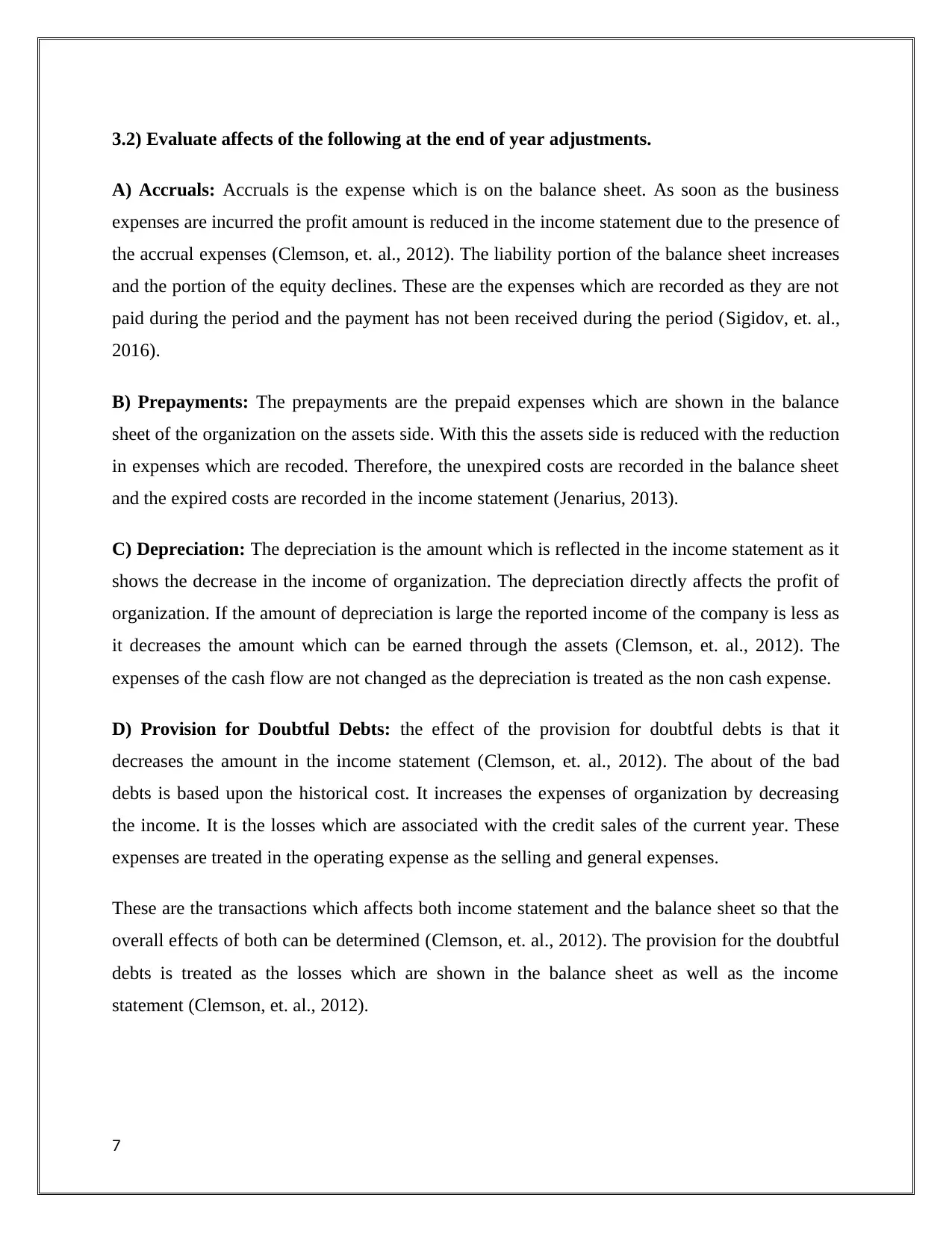
3.2) Evaluate affects of the following at the end of year adjustments.
A) Accruals: Accruals is the expense which is on the balance sheet. As soon as the business
expenses are incurred the profit amount is reduced in the income statement due to the presence of
the accrual expenses (Clemson, et. al., 2012). The liability portion of the balance sheet increases
and the portion of the equity declines. These are the expenses which are recorded as they are not
paid during the period and the payment has not been received during the period (Sigidov, et. al.,
2016).
B) Prepayments: The prepayments are the prepaid expenses which are shown in the balance
sheet of the organization on the assets side. With this the assets side is reduced with the reduction
in expenses which are recoded. Therefore, the unexpired costs are recorded in the balance sheet
and the expired costs are recorded in the income statement (Jenarius, 2013).
C) Depreciation: The depreciation is the amount which is reflected in the income statement as it
shows the decrease in the income of organization. The depreciation directly affects the profit of
organization. If the amount of depreciation is large the reported income of the company is less as
it decreases the amount which can be earned through the assets (Clemson, et. al., 2012). The
expenses of the cash flow are not changed as the depreciation is treated as the non cash expense.
D) Provision for Doubtful Debts: the effect of the provision for doubtful debts is that it
decreases the amount in the income statement (Clemson, et. al., 2012). The about of the bad
debts is based upon the historical cost. It increases the expenses of organization by decreasing
the income. It is the losses which are associated with the credit sales of the current year. These
expenses are treated in the operating expense as the selling and general expenses.
These are the transactions which affects both income statement and the balance sheet so that the
overall effects of both can be determined (Clemson, et. al., 2012). The provision for the doubtful
debts is treated as the losses which are shown in the balance sheet as well as the income
statement (Clemson, et. al., 2012).
7
A) Accruals: Accruals is the expense which is on the balance sheet. As soon as the business
expenses are incurred the profit amount is reduced in the income statement due to the presence of
the accrual expenses (Clemson, et. al., 2012). The liability portion of the balance sheet increases
and the portion of the equity declines. These are the expenses which are recorded as they are not
paid during the period and the payment has not been received during the period (Sigidov, et. al.,
2016).
B) Prepayments: The prepayments are the prepaid expenses which are shown in the balance
sheet of the organization on the assets side. With this the assets side is reduced with the reduction
in expenses which are recoded. Therefore, the unexpired costs are recorded in the balance sheet
and the expired costs are recorded in the income statement (Jenarius, 2013).
C) Depreciation: The depreciation is the amount which is reflected in the income statement as it
shows the decrease in the income of organization. The depreciation directly affects the profit of
organization. If the amount of depreciation is large the reported income of the company is less as
it decreases the amount which can be earned through the assets (Clemson, et. al., 2012). The
expenses of the cash flow are not changed as the depreciation is treated as the non cash expense.
D) Provision for Doubtful Debts: the effect of the provision for doubtful debts is that it
decreases the amount in the income statement (Clemson, et. al., 2012). The about of the bad
debts is based upon the historical cost. It increases the expenses of organization by decreasing
the income. It is the losses which are associated with the credit sales of the current year. These
expenses are treated in the operating expense as the selling and general expenses.
These are the transactions which affects both income statement and the balance sheet so that the
overall effects of both can be determined (Clemson, et. al., 2012). The provision for the doubtful
debts is treated as the losses which are shown in the balance sheet as well as the income
statement (Clemson, et. al., 2012).
7
Paraphrase This Document
Need a fresh take? Get an instant paraphrase of this document with our AI Paraphraser
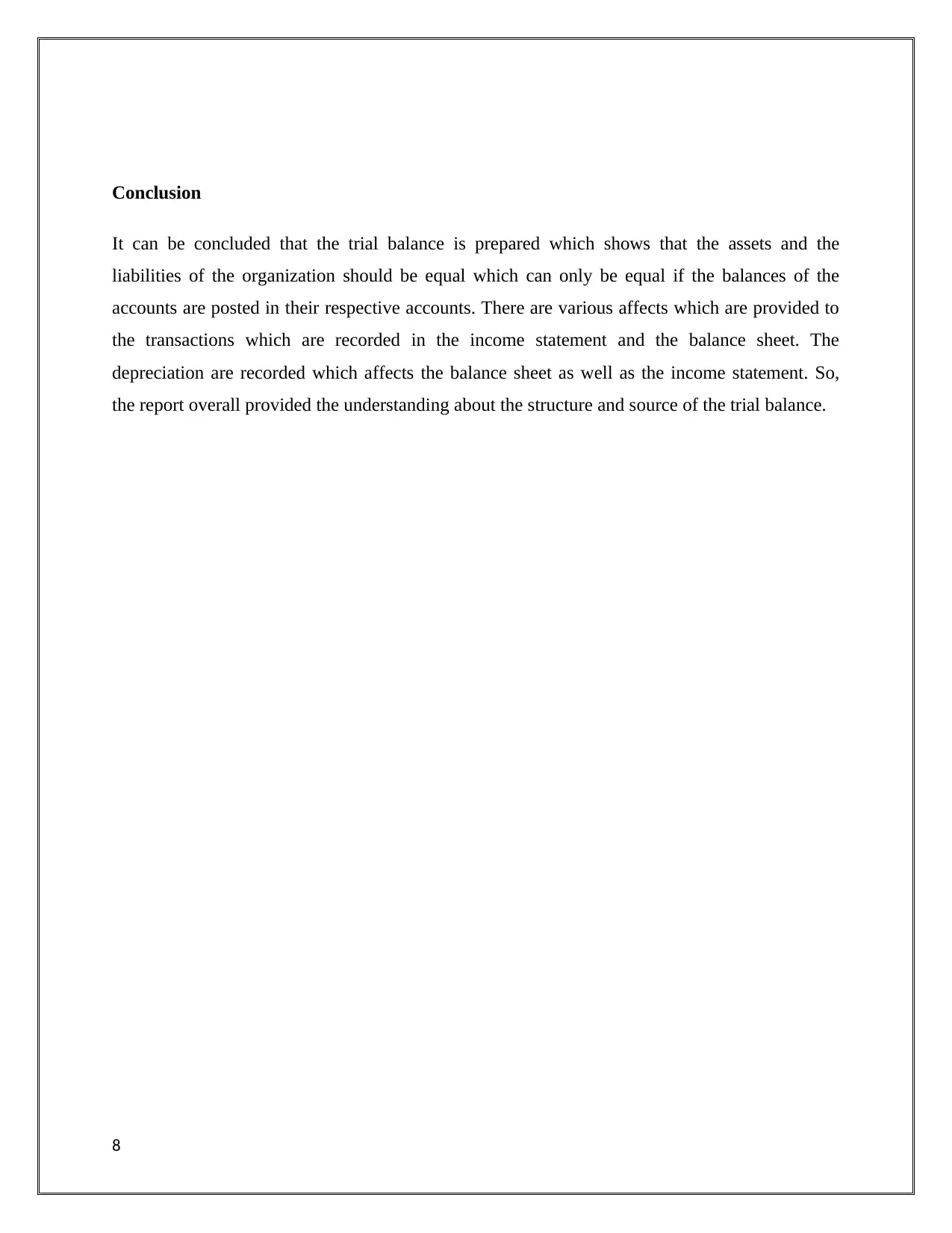
Conclusion
It can be concluded that the trial balance is prepared which shows that the assets and the
liabilities of the organization should be equal which can only be equal if the balances of the
accounts are posted in their respective accounts. There are various affects which are provided to
the transactions which are recorded in the income statement and the balance sheet. The
depreciation are recorded which affects the balance sheet as well as the income statement. So,
the report overall provided the understanding about the structure and source of the trial balance.
8
It can be concluded that the trial balance is prepared which shows that the assets and the
liabilities of the organization should be equal which can only be equal if the balances of the
accounts are posted in their respective accounts. There are various affects which are provided to
the transactions which are recorded in the income statement and the balance sheet. The
depreciation are recorded which affects the balance sheet as well as the income statement. So,
the report overall provided the understanding about the structure and source of the trial balance.
8
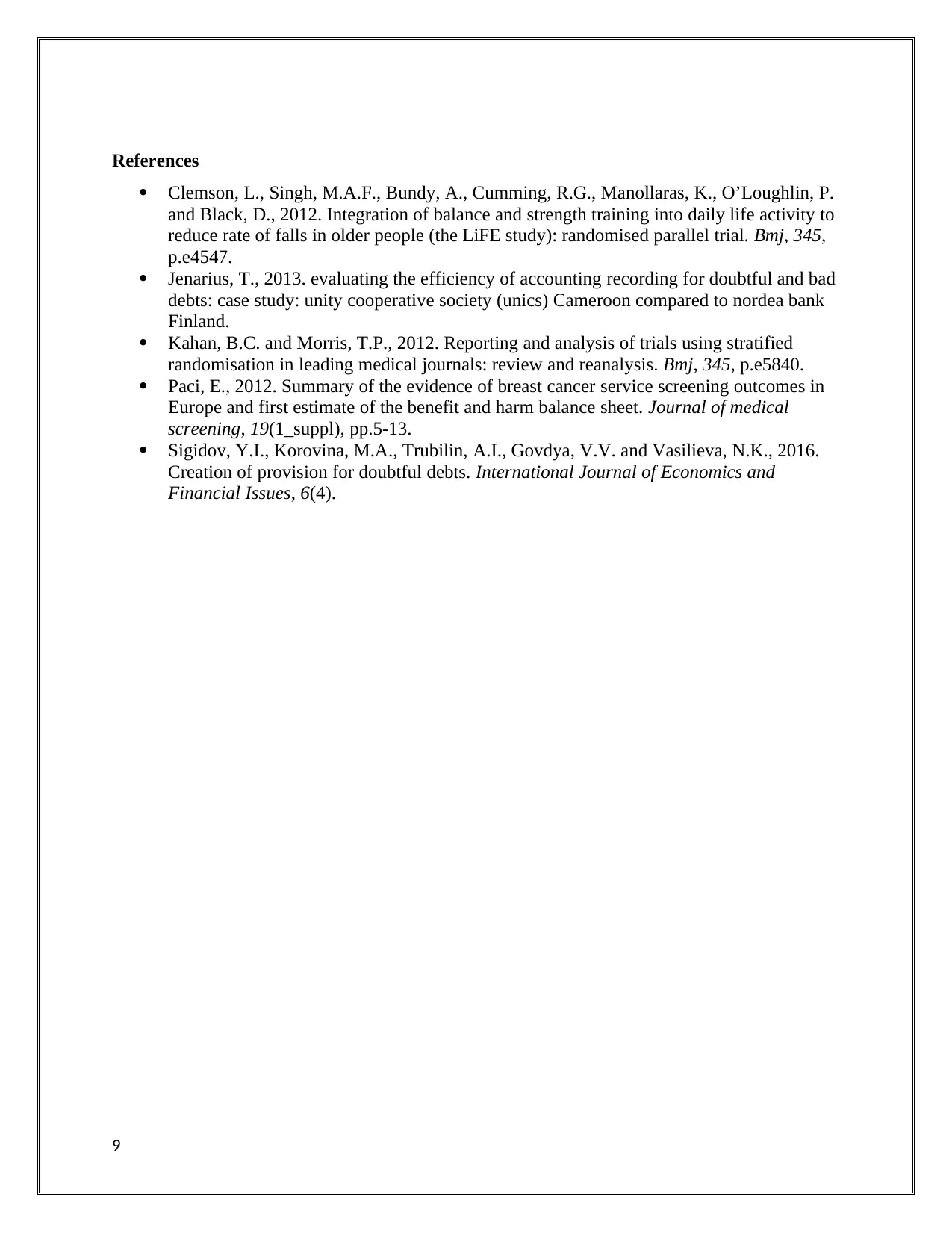
References
Clemson, L., Singh, M.A.F., Bundy, A., Cumming, R.G., Manollaras, K., O’Loughlin, P.
and Black, D., 2012. Integration of balance and strength training into daily life activity to
reduce rate of falls in older people (the LiFE study): randomised parallel trial. Bmj, 345,
p.e4547.
Jenarius, T., 2013. evaluating the efficiency of accounting recording for doubtful and bad
debts: case study: unity cooperative society (unics) Cameroon compared to nordea bank
Finland.
Kahan, B.C. and Morris, T.P., 2012. Reporting and analysis of trials using stratified
randomisation in leading medical journals: review and reanalysis. Bmj, 345, p.e5840.
Paci, E., 2012. Summary of the evidence of breast cancer service screening outcomes in
Europe and first estimate of the benefit and harm balance sheet. Journal of medical
screening, 19(1_suppl), pp.5-13.
Sigidov, Y.I., Korovina, M.A., Trubilin, A.I., Govdya, V.V. and Vasilieva, N.K., 2016.
Creation of provision for doubtful debts. International Journal of Economics and
Financial Issues, 6(4).
9
Clemson, L., Singh, M.A.F., Bundy, A., Cumming, R.G., Manollaras, K., O’Loughlin, P.
and Black, D., 2012. Integration of balance and strength training into daily life activity to
reduce rate of falls in older people (the LiFE study): randomised parallel trial. Bmj, 345,
p.e4547.
Jenarius, T., 2013. evaluating the efficiency of accounting recording for doubtful and bad
debts: case study: unity cooperative society (unics) Cameroon compared to nordea bank
Finland.
Kahan, B.C. and Morris, T.P., 2012. Reporting and analysis of trials using stratified
randomisation in leading medical journals: review and reanalysis. Bmj, 345, p.e5840.
Paci, E., 2012. Summary of the evidence of breast cancer service screening outcomes in
Europe and first estimate of the benefit and harm balance sheet. Journal of medical
screening, 19(1_suppl), pp.5-13.
Sigidov, Y.I., Korovina, M.A., Trubilin, A.I., Govdya, V.V. and Vasilieva, N.K., 2016.
Creation of provision for doubtful debts. International Journal of Economics and
Financial Issues, 6(4).
9
⊘ This is a preview!⊘
Do you want full access?
Subscribe today to unlock all pages.

Trusted by 1+ million students worldwide
1 out of 9
Related Documents
Your All-in-One AI-Powered Toolkit for Academic Success.
+13062052269
info@desklib.com
Available 24*7 on WhatsApp / Email
![[object Object]](/_next/static/media/star-bottom.7253800d.svg)
Unlock your academic potential
Copyright © 2020–2025 A2Z Services. All Rights Reserved. Developed and managed by ZUCOL.





